10 most bizarre and interesting animal species discovered in recent years
 Bashny.Net
Bashny.Net
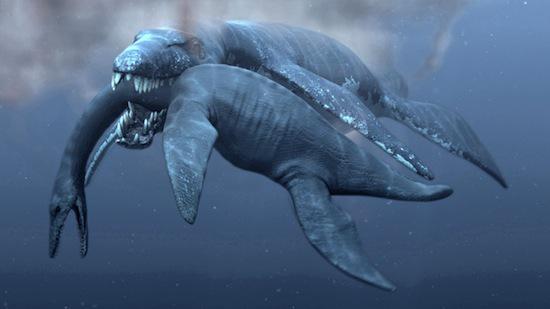
Recently opened a lot of terrible, strange and interesting animals - worms zombie fish penises, not to mention the turtles with a strange way of urination. We offer you a selection of the ten most unusual new species.
1. "Tulip" digestive sistemoy

Ancient fossil found in Canada, looks like a field of tulips carved in stone - in fact it is allowed only superficially similar to the plants.

Siphusauctum gregarium, animals that live on the planet 500 million years ago, fed by filtering plankton: the length of it was with a table knife, and at the end of the "stem" a head the size of a bulb. Digestive system sifuzauktuma was a strange pores and gut: After filtering the water through the outer pores, animal, apparently, "banishes" water through the tulip head, absorbing any food particles that get there.
Scientists do not fully understand how this unusual creature fits into the evolutionary tree.
2. Fancy being in kokone
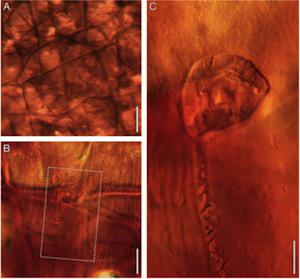
Failure trapped in an ancient animal became success for modern scientists: lived on earth about 200 million years ago, slimy leech cocoon allocated under water or on a wet plant, which cater to a tiny animal is no longer than a millimeter, which failed to get out later.
This little creature caught on something its spiraling tail and was absorbed by a cocoon: the unusual circumstances have led to something almost unheard - complete preservation spineless animal, which has no hard skeleton or shell for the formation of fossils.
3. Night-lemurs kannibaly

Optionally, up to 12 m in length to be scary: last year, researchers studying charming gray lemur (Microcebus Murinus) in Madagascar, came across a terrible picture - the male of this species eating the flesh of dead females.
While other primates (including humans) are known to practice cannibalism, scientists have never seen before, that the animals were eating the bodies of their relatives in such numbers - this case has been described in the American Journal of Primatology.
4. Centipede, which has 750 nog

White millipedes have 750 feet of wavy on the body, not exceeding three cm in length: Illacme plenipes - a world record for the number of legs. It lives only in the area of 4, 5 square kilometers in the area of Northern California, and it's strange because the next "family" creatures live in South Africa.
Millipedes could spread throughout the world, where most of the Earth's land was part of the supercontinent - Pangaea, and when the supercontinent broke up 200 million years ago, centipedes were on another continent.
5. marine predators against which the Tyrannosaurus looks slabakom
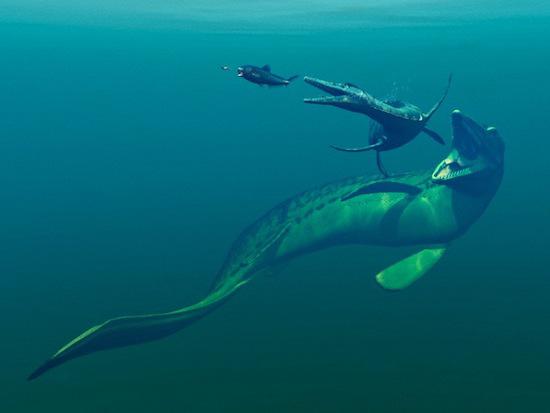
Once on Earth existed horrible sea creature, even more unusual than an animal, like a flower - the giant marine reptile was the main predator of the seas 150 million years ago, and in 2012 was finally officially called.

Pliosaurus funkei up to 12 m in length, two of which were in the skull. "They had teeth that would have made whining tyrannosaur," - said a paleontologist at the University of Alaska, Patrick Druckenmiller.
6. Snakes with schupaltsami
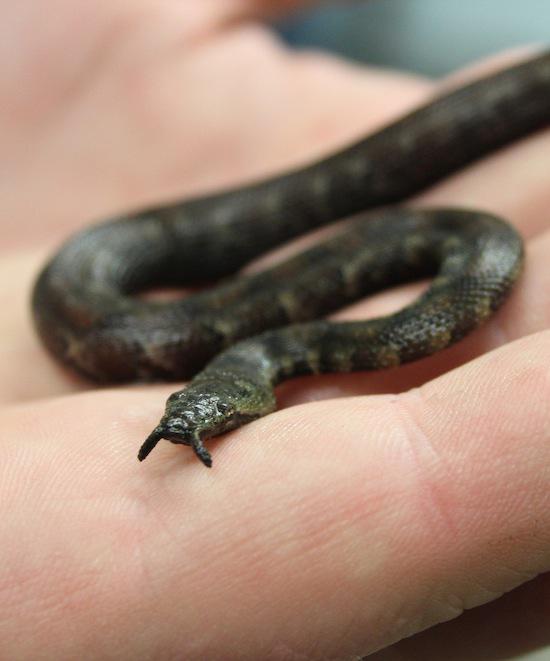
In October last year at the National Zoo Smithsonian born eight tentacled snakes.
Zoo staff have tried to breed the rare species of water snakes Erpeton tentaculatus for four years, until the case finally was not successful. These strange snake native to Southeast Asia are the only snakes with two small tentacles on his face: they work as well as his mustache in other animals, snakes and help catch the vibrations of swimming fish.
7. Fish head-penisom
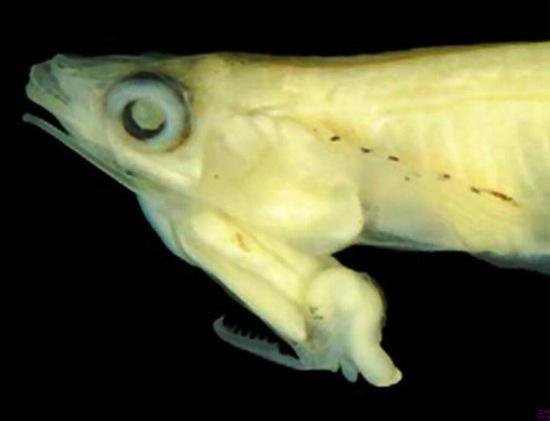
This fish has a strange anatomical structure - the researchers reported finding fish with a penis on his head in the Mekong Delta in Vietnam in August last year.
And it's not just the penis - the body includes gear hooks to capture the female during mating (female genitals are located on the neck).
The species is named Phallostethus cuulong and is one of the few species that fertilized eggs inside the female body, not outside. Disgusting-looking hook appendage probably came to the male sperm is guaranteed to come to the right place.
8. Sponge-myasoed
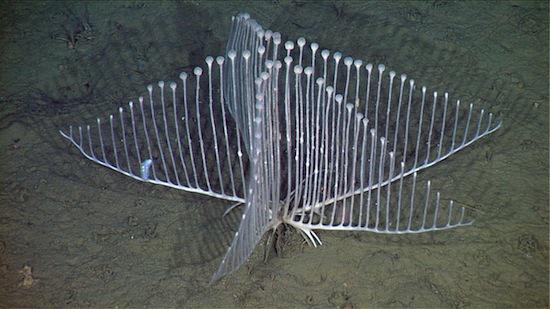
The animal resembles a harp or thin chandelier, but any crustaceans have to be on guard with him and did not move up too close: the so-called "harp sponge" catch crayfish in the trap and digest before it is noticed.
It really is a strange creature, and people are unaware of its existence until the year 2000, while the team from the Research Institute of «Monterey Bay Aquarium» California immerse equipment with a remote control to a depth of 3, 5 km off the coast of central California.
They caught two animals, later called Chondrocladia lyra, and installed more surveillance of ten copies. Sponges feed by clinging to muddy sand on the ocean floor and allowing ocean currents bring accidents tiny crustaceans to their multiple limbs.
9. Zombie chervi
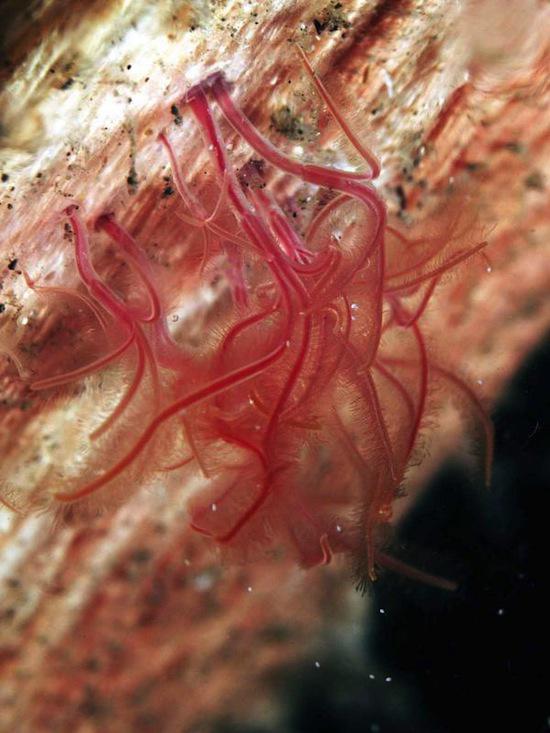
Zombie worm feeds on the bones of whales and other sea creatures, despite the lack of a mouth. In July last year, researchers at the annual meeting of the Society for Experimental Biology announced that they understand how the creature eats bones - it secretes acid.
Acid allows worms destroy and devour the bones, but it's just the tip of the iceberg: the strange thing is how well these worms have adapted to the conditions of their environment. Females grow up to three centimeters in length, but males are never more than one mm males appear to live in gelatin tubes covering the females, and has no function other than fertilization of eggs.
10. Turtle, which is wetted by rot
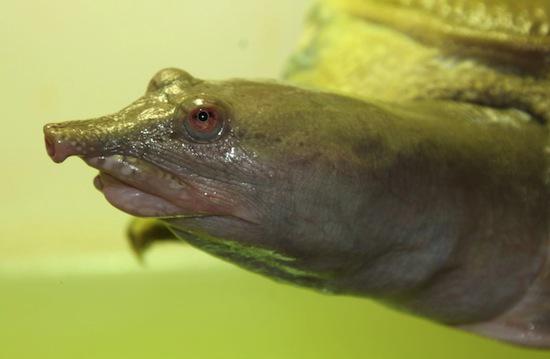
Turtles have been found in China, often dipped his head with acute stigma in puddles on the land - why do they do it long remained a mystery, given that these animals breathe air. Now scientists have found out why this is happening - Chinese myagkopantsirnye turtle (Pelodiscus sinensis) urinate through the mouth.
Turtles excrete urea, the main component of urine through the gills in the mouth - before this ability has only been observed in some species of fish. Since turtles can not get enough fresh water to wash the urea in the urine, they transport it through the gills, and then washed them in a pool with salt water.
via factroom.ru
Tags
See also
10 new species discovered in the last year
The strangest animal planet
Flora and Fauna of Suriname (25 photos)
10 species
10 amazing tiny species
Selection of the most bizarre car
The most unusual animals, opened recently (20 photos)
3 kinds of animals that were immortal
Environmentalists from WWF talking about opening a dozen new species in Vietnam
10 most bizarre wars (10 photos)

















